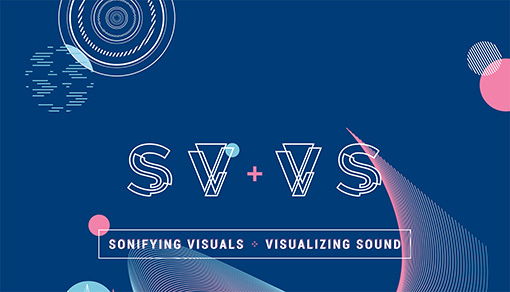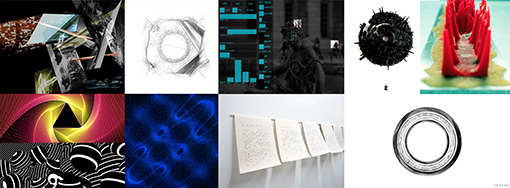

The Giga-Hertz Prize is sponsored by ZKM Karlsruhe (Das Zentrum für Kunst und Medien), and the SWR Experimental Studio, Baden-Baden, Germany. The awards ceremony will be held at the 2016 Giga-Hertz Preis Festival at ZMK Karlsruhe, November 24-27, 2016.

www.news.ucsb.edu/2016/017479/unanticipated-honor
zkm.de/pressemappe/2016/giga-hertz-preis-2016-fuer-den-us-komponisten-curtis-roads
The talk will be presented in the section titled "Creating Immersive Experiences: Virtual Reality and the Brain".
The European Network for Contemporary Audiovisual Creation (ENCAC) is pleased to announce this year’s winners of their annual open call. Totalling 186 submitted projects from 34 countries, a wide range of approaches from developers, performers, visual artists, film makers, choreographers and musicians, composers and sound artists presented their particular visions of the potential for audiovisual creativity in cross-disciplinary fields.
Winning projects are: “ÆTEROFONER” by Christian Skjødt, "Embodied Gestures" by Enrique Tomás, "Manufactory" by Transforma, "Permafrost" by Adam Basanta and Gil Delindro, "Aeryon" by Maotic and "Soft Probe" by Matthew Biederman and Marko Peljhan. Each of the 6 winning artists will be awarded a residency at one of the following institutions: Avatar, Quebec, CTM Festival DISK, Berlin, hTh Montpellier, LABoral Centro de Arte y Creación Industrial, Gijón and Le Lieu Unique, Nantes.
The jury was formed by ENCAC’s curatorial committee:
Le Lieu Unique will host Matthew Biederman and Marko Peljhan for their project, "Soft Probe - the Edges of SDR (software-defined radio)". The artists propose to research and create a tactical environment using software-defined radios for insight into contemporary telecommunication paradigms. The jury is convinced that the artists’ political stance and artistic experience will produce an impact on research which underlines the fragility of contemporary telecommunication infrastructures. Biederman and Peljhan’s use of open source equipment and software, their focus on our current loss of privacy and their keen understanding of the shifts brought about by SDR technology will ensure that "Soft Probe" comes out as a live and autonomous electromagnetic spectrum probe that charts today’s machines, raising awareness of what we emit without knowing it.
www.ctm-festival.de/news/encac-audiovisual-network-announces-6-winning-projects
The topics included "documentary and virtual reality", "ambiances in actual and virtual environments", "dance, movement, and emotion as computational interfaces", "advanced supercomputing and scientific visualization", "the exploration of the continuum between music and architecture through Xenakis", and "the rapidly evolving emerging possibilities of reinvigorated and expanding social VR".
Virtually There: Documentary Meets Virtual Reality Conference and Exhibition
May 6-7, 2016
MIT Open Documentary Lab
Movement and Emotion as Computational Interfaces Workshop and Speaker Series
June 6-12, 2016
York University • School of the Arts, Media, Performance, and Design • Toronto, Canada
From Xenakis to the Present: the Continuum in Music and Architecture
June 13-14, 2016
University of Cyprus, Department of Architecture
European University of Cyprus, Music Department
World16 International VR Symposium and 7th Summer Workshop
July 12-15, 2016
Cybermedia Center, Osaka University, Japan
RIKEN Advanced Institute for Computational Science, K Computer
Ambiances, Tomorrow: 3rd International Congress on Ambiances
September 21-24, 2016
University of Thessaly, Department of Architecture, Volos, Greece
International Ambiances Network (www.ambiances.net)
Scientific Thematic Network of the French Ministry for Culture and Communication, France
The award provides funding for an academic year, and is intended to assist recipients in acquiring and developing sophisticated research skills under faculty mentorship. Cecilia is working under the supervision of her graduate mentor Professor Curtis Roads.
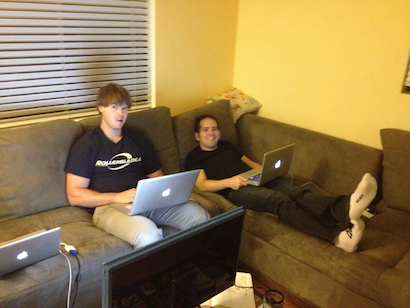
"Early Days". Pictured: two of the three company founders, Ryan McGee (left) and Michael Hetrick (right).
Article:
www.plugin-alliance.com/en/news/article/items/unfiltered-audio-developer-story.html
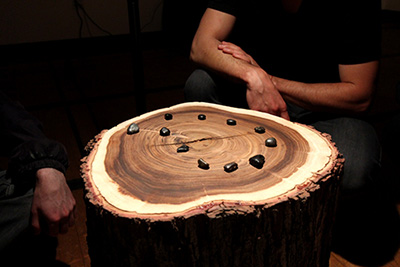
Dates: September 8 - October 28
Curated by Lorraine Walsh, with Margaret Schedel and Joo Yun Lee
Featuring the work of Memo Akten, Sougwen Chung, Seth Cluett, Yoon Chung Han, Carsten Nicolai, Jess Rowland.
The exhibition is curated by MAT PhD candidate Yoon Chung Han, currently an assistant professor at California State University, Fullerton, and features works by Reza Ali, Juan Manuel Escalante, Yuan-Yi Fan, Haru Ji + Graham Wakefield, George Legrady, Ryan McGee, F. Myles Sciotto, with Camella DeEun Kim and Erick Oh both formerly from UCLA. The exhibition will take place at the Dongdaemun Design Plaza Museum (DDP), designed by Zaha Hadid Architects.
www.zaha-hadid.com/architecture/dongdaemun-design-park-plaza
Also on display is work by Art student Miranda O'Mahoney titled "Manifest". The Glass Box Gallery is located in the Art Department building. Opening reception is Thursday, July 14 at 7pm.

Aaron was awarded one of three Best Paper awards at the 2016 ACM SIGGRAPH / Eurographics Symposium on Computer Animation in Zürich Switzerland. He received it for his paper, "Compressing Fluid Subspaces" which he co-authored with Professors Theodore Kim and Pradeep Sen of the MIRAGE lab at UCSB.

The new space will feature a 3D screen and spatialized audio to provide an "immersive" experience, that will showcase installations that are designed to provide insight into the fields of Science, Technology, Engineering, Arts and Mathematics (STEAM).
The MOXI Museum (the Wolf Museum of Exploration and Innovation) is scheduled to open in downtown Santa Barbara at the end of 2016, and will provide over 17,000 square feet of exhibits arranged in eight themed areas.

Mr. Shao was the lead author for a paper titled "Learning Constituent Parts of Touch Stimuli from Whole Hand Vibrations", and Ms. Chartier was the lead author of a paper titled "Toward a Wearable Tactile Sensory Amplification Device: Transfer Characteristics and Optimization". The lab also contributed a paper titled "Exploring Haptic Working Memory as a Capacity Limited Information Channel", which was also recognized as a finalist for the Best Paper Award. The latter was a collaboration with Rachel Lerch (lead student author), and Professor Chris Sims, both of Drexel University.
Symposium website: 2016.hapticssymposium.org
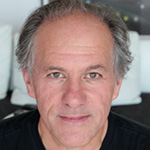
The Board of Trustees of the John Simon Guggenheim Memorial Foundation approved the awarding of 175 Guggenheim Fellowships to a diverse group of distinguished scholars, artists, and scientists. Appointed on the basis of prior achievement and exceptional promise, the successful candidates were chosen from a group of nearly 3,000 applicants in the Foundation’s ninety-second competition.
With his grant, Professor Legrady will create a research project and installation titled "Aesthetic Metavision", that builds on a recently realized series of projects, "Swarm Vision", "Exquisite Vision", and "AutoVision", developed with graduate students Danny Bazo, Marco Pinter, and Jieliang (Rodger) Luo in the Experimental Visualization Lab. The arts-engineering research focuses on questions concerned with training an autonomous multi-camera system to acquire aesthetics-defined behavior and agency.

Turing Machine, reconstructed by Mike Davey, image by Rocky Acosta
Abstract
Today, the Turing machine is widely regarded as the best possible definition of computability, such that there are definitions of equivalent but not greater formal accuracy and power. But what is it? While references to the Turing machine abound in all academic fields, this question has not been answered, maybe not even asked properly, from the ontological perspective. To firstly understand what it implies, and, secondly, provide a preliminary discussion of possible answers, is what this paper is trying to achieve. Specifically, this paper posits that the rhetoric construction of the Turing machine by means of the simile "human <> machine" mirrors exactly its mathematical construction, as the rhetoric ambiguity created by the simile mirrors exactly the mathematic "ambiguity" that, following Robin Gandy’s "principles for mechanisms" is a necessary prerequisite to the formal construction of any machine. It argues that it is precisely a lack of information, a lack of precision, a lack of clarity that allows Turing to construct rhetorically first what then is developed mathematically.
Conference website: imagehe.re
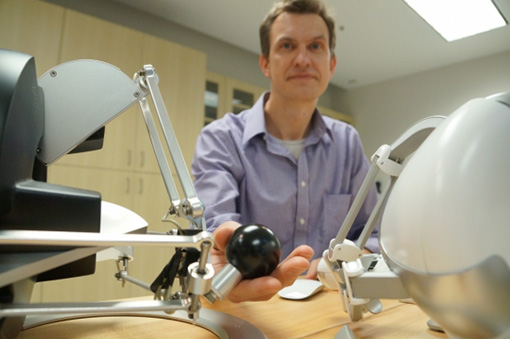
Photo: Sonia Fernandez, UCSB
The paper sheds light on the surprisingly rich structure in signals felt by the hand when touching, grasping, or manipulating objects.
www.pnas.org/content/early/2016/03/25/1520866113
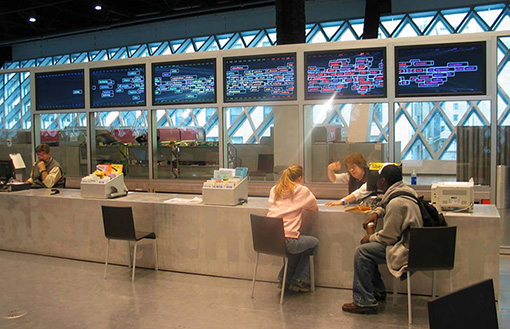
Date: Tuesday, March 22nd, 2pm.
Location: The Institute for Pure and Applied Mathematics, UCLA
The presentation will begin with an introduction to the "Making Visible the Invisible" installation at the Seattle Public Library, an artwork that maps on 6 large LCD screens, the activities of library checkouts received by the hour. Begun in September 2005, the installation may be the longest continuously running data visualization project.
The second half of the presentation focuses on student work created using the over 78 million datasets collected to-date by the Seattle Library Project. The data has been used in a Data Visualization Course for the past 8 years. Students acquire skillsets in a ten week period to analyze the data with MySQL and create various types of visualizations in 2D and 3D.
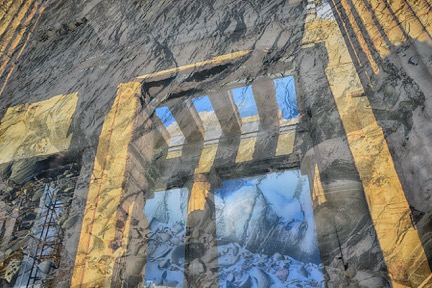
Propylaea, by David Gordon
Reception: Saturday March 19th, from 7pm - 10pm.
The HUD Gallery + Studios
1793 East Main St, Ventura, CA
From the press release:
Through merging images, David Gordon uncovers striking juxtapositions and unexpected parallels between distinct subjects or places. These images explore visual paradoxes and ambiguities through manipulation of scale, perspective, color, material and texture. This process abstracts each image from its spatial and temporal context. The resulting composites suggest dreamlike, alternative realities and examine the process by which meaning arises through association of memories with present experience. From where you stand to observe, a virtual window is created to separate you from your existence.
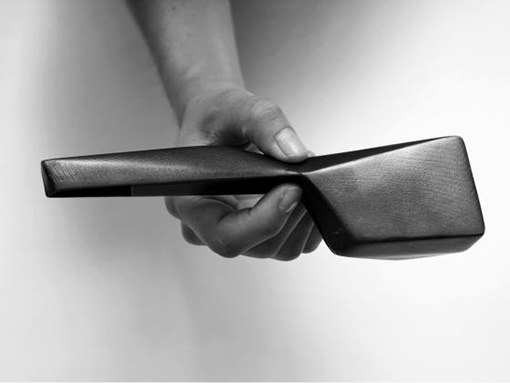
Diller Scofidio + Renfro: Hand holding a model for BAMPFA, 2012; digital photograph. Courtesy and © Diller Scofidio + Renfro.
Event Dates: January 31 – May 29, 2016
Architecture of Life, the inaugural exhibition in BAMPFA's landmark new building, explores the ways that architecture, as concept, metaphor, and practice, illuminates various aspects of life experience: the nature of the self and psyche, the fundamental structures of reality, and the power of the imagination to reshape our world. Occupying every gallery in the new building, designed by Diller Scofidio + Renfro, the exhibition comprises over two hundred works of art in a wide range of media, as well as scientific illustrations and architectural drawings and models, made over the past two thousand years. Boundary-breaking, innovative, and radically interdisciplinary, the exhibition presents visually exquisite, rarely seen works in ways that suggest new connections and meanings.
Abstract
As digital technology ages, the conservation of digital art becomes an increasing challenge to museums and collections. Early digital artworks have aged to a degree that all of their technical context, all of the technical setup to make them work, has been lost to attrition. Two basic strategies of conservation have emerged in recent years: substitution, the simple replacement of broken with either new or used parts, and portation, the adaption of a work to an entirely new technical context. This paper proposes a new intermediate strategy of conservation that is intended to complement these existing strategies. Unlike these existing strategies, however, the strategy of conservation presented here explicitly acknowledges the fact that the computer - as the medium of digital art - is a symbolic machine that exists in the material and the symbolic realm alike. Based on this acknowledgement, it suggests to treat conservation as translation, and thus to treat digital artworks as objects that can be translated from the material into the symbolic realm, where they can be stored redundantly and indefinitely. Finally, it posits that by using standardized hardware description languages as the translation target, and programmable logic devices as the medium of a digital artwork’s resurrection in the material realm, a level of conservation can be achieved that is unattainable with substitution or portation alone.
Conference website: handson2016.wordpress.com
